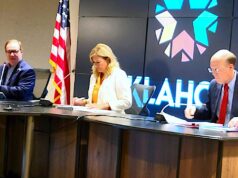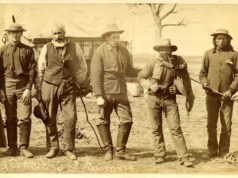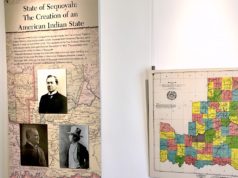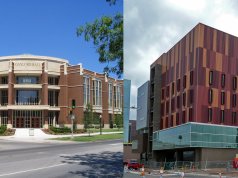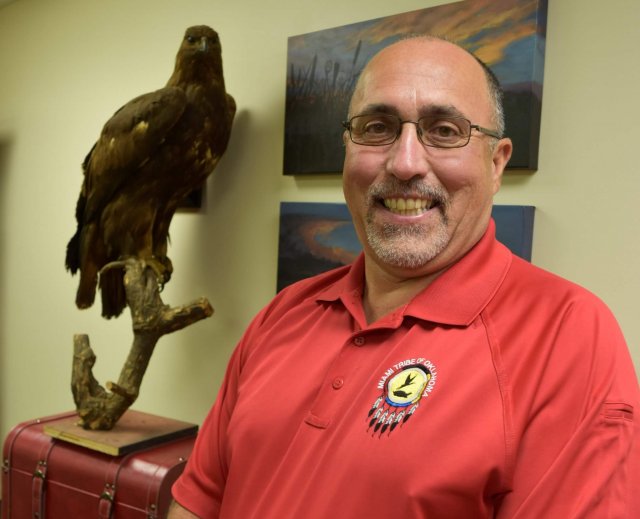
“Myaamionki” means all the places the Miami people have ever lived, whether past or present.
Saakiiweeyonki, or Coming Out Place, was the original Miami Nation village established in the Great Lakes region, near where the St. Joseph’s River empties into Lake Michigan.
“From there, we settled into the Wabash River Valley mostly and that became the epicenter,” said Joshua Sutterfield, cultural education coordinator for the Miami Nation. “And from there we went everywhere…so we scattered the Wabash River Valley with villages. Each of those villages were autonomous. They had their own leaders.”
This story was reported by Gaylord News, a Washington reporting project of the Gaylord College of Journalism and Mass Communication at the University of Oklahoma. This series entitled “Exiled to Indian Country” details the stories of how each of Oklahoma’s 39 tribes ended up in the state.
Sutterfield said the Miami Nation numbered about 24,000, prior to the turn of the 18th century.
By 1795, their lands encompassed Indiana, western Ohio, eastern Illinois, lower Michigan and lower Wisconsin. Beginning with the Treaty of Greenville on Aug. 3, 1795, massive cessions of territory were forced on the tribe.
Diane Hunter, tribal historic preservation officer, said more land cessions happened between 1805 and 1834. Finally, the Treaty of 1838 created the Great Miami Reserve, a 500,000-acre reservation in Indiana.
Hunter said the Removal Act of 1830 by President Andrew Jackson had a bearing on the eventual removal of the Miami.
“Obviously, one led to the other. Our removal was a direct result of that Indian Removal Act, but also, we could see how other tribes were being removed,” Hunter said. “We were the last to be removed from that Indiana area.”
Sutterfield agreed.
“It gave a lot of power to the state of Indiana, because in 1829, only one year prior, they passed a resolution asking for the removal of the Miami and other tribes…so not only does Indiana want it, now all of a sudden they’ve got [Washington] D.C. standing behind them,” Sutterfield said.
Hunter described the prevailing attitude toward the tribes.
“Let’s get the Indians out of our way,” he said. “Let’s put them west of the Mississippi where we don’t have to see them, and we don’t have to deal with them anymore.”
However, the Miami didn’t think they would have to leave.
“We really believed there would be a way around it,” Hunter said.
Part of the money from the proceeds of the Treaty of 1838 was designated to pay the debts of Miami individuals. (President Thomas Jefferson years before wrote to William Henry Harrison encouraging debt escalation to drive future land cessions.) The remainder was to be paid in annuities. The ceding of the Great Miami Reserve was in exchange for 500,000 acres beyond the Mississippi River, the “permanent solution, distant from our frontier,” for which the Indiana Legislature had vehemently argued on the Senate floor.
The Treaty of the Wabash allowed five years for the tribe to relocate. Chief John Baptiste Richardville died in 1841, shortly after signing the treaty. By this time, half the tribe was exempted from removal by private land acquisitions and changes in citizenship.
‘We were cargo’

journey would not end in Kansas. (Miami Nation
On Oct. 6, 1846, just more than 300 Miami people were herded onto canal boats at gunpoint.
“We’re putting it off [removal] and suddenly here’s the U.S. Army guns blazing, if you will(…)at gunpoint and rounding up [at people] from their villages and taking them to Peru, Indiana,” Hunter said.
Those who resisted were threatened. Grieving departure, some grabbed handfuls of earth from the homeland and placed it in tobacco sacks to take with them.
Hunter described the month-long journey west.
“We are traveling on the canal boats, [on the] Wabash-Erie Canal through Fort Wayne, and up close to Defiance, Ohio, where the Wabash-Erie Canal meets the Miami-Erie Canal,” he said. “And we took the boats south to Cincinnati.”
They were transferred to the Steamship Colorado in Cincinnati. Cargo was listed in that day’s publication of the Cincinnati Gazette.
“One hundred thirty-four barrels of whiskey, 10 sacks of 115 pounds of wool, eight barrels of varnish, two Indian ponies, Miami Indians—225 over and 78 under 8 years old, 49 perch stones for pigs,” the newspaper reported.
“We were cargo,” Hunter said. “We were not passengers. So, they loaded us onto the Steamboat Colorado, took us along the Ohio River and then to the Mississippi up to St. Louis.”
From St. Louis, they traveled the Missouri River to Kanza Landing, the beginning of what would one day be Kansas City. Sugar Creek was their eventual destination, 50 miles to the south. There, they began to adapt to the new land and build homes. But the 500,000 acres promised in the Treaty of 1840 turned out to be 350,000.
A trader witnessed the arrival at Kanza Landing. Many tribal members burst into tears because of the traumatic separation from their traditional land in Indiana.
“The trader said they begged like children to take them back to their home. He could not help crying also,” Sutterfield said.
The “permanent solution” called for by the Indiana legislature lasted a little more than 20 years until the Treaty of 1867, which called for a second forced removal, this time to Oklahoma. According to Hunter, government leaders had not realized what they had in Kansas at the time.
“After the Civil War…there were squatters. They were discovering that this is really good farmland. They were discovering that there were mineral deposits, natural gas…that this was a valuable land and they wanted it.”
This time the government didn’t come with guns, but with a threat to their identity.
A threat to the past
Tribal members were given three options. They could denounce their Miami citizenship and stay in Kansas. They could join the Peoria tribe which had already moved to Oklahoma. Or they could acquire land in Oklahoma and continue to be the Miami tribe.
“Fortunately, our tribal leadership chose to maintain the Miami tribe, bought land from the Peoria for our reservation, and moved the tribe to Oklahoma,” Hunter said. The Miami had been closely tied to the Peoria while in Indiana.
Rose Carver, born in 1885, later described the horrifying scene, as passed down from her mother, of the forced removal from Kansas to Indian Territory.
“They come in [train] cars and shipped ‘em like cattle—from Kansas up here, just like cattle in cattle cars. It was terrible. Then they sold the Indian land. Some bought it for 10 cents an acre. Some got it for a package of tobacco or a quart of whiskey.”
By the time they arrived in Oklahoma in 1867, they numbered fewer than 100. The Miami and Ottawa chiefs agreed the town would be named Miami, and the county would be called Ottawa—both names remain today.
“Whether it’s our ancestral lands or our removal lands or our contemporary lands, those are the places that have always been or have become Myaamionki. Those are the places our ancestors have lived and died. The places where they were buried. Our ancestors are the dust of that land,” Hunter said.
Miami Chief Douglas Lankford said they will never forget their past and will always have a foot there. Indiana remains their ancestral homeland, and that will never change.
“We leave the past, but the past never leaves us,” Lankford said.
People who took U.S. citizenship in the 1800s forfeited their status with the Miami Nation, but Lankford said they are coming back in droves. He stated that the Miami Nation adds 10 to 20 people to the tribal roll every month.
“It’s a good day to be Myaamia. It’s kind of that snowball rolling down the hill. It’s exponential growth [for us] now.”
The Miami numbers more than 5,000 today. Every event draws more people, and they outgrow buildings faster than ever before.
“I understand why living communally was how we did so well, because being together is a really great time for us,” Lankford said. “Relationships are key. They maintain a vital, strategic relationship with Miami University in Oxford, Ohio.
“I’m a little different than most. There is a hole from the past. I never wished the past away because I would wish myself away. Things have to happen(…)our past is something to be learned from. You don’t make the same mistakes again and that’s what I try to do. Every culture, every country, everybody has bad things in the past, but it’s what brings us to who we are today.”












